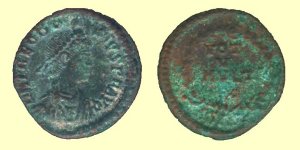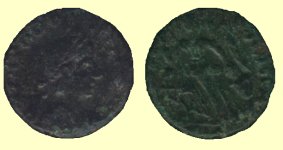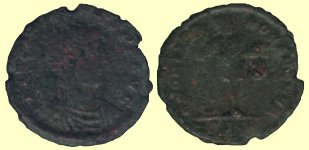Theodosius I 379 - 395 A.D.
By clicking on the pictures you'll be linked to a more complete description of the coin. At the bottom of this page there is a more elaborate biography of the emperor.
| Obverse: DN THEODOSIVS PF AVG | |
| Reverse: CONCORDIA AVGGG | |
|
Fieldmarks: a Θ (theta) in the left field and a Φ
(phi) in the right field
|
|
| Exergue: ANTΔ |
 |
Obverse: DN THEODOSIVS PF AVG |
| Reverse: VOT V MULT X | |
|
Fieldmarks: -
|
|
| Exergue: ASISC |
 |
Obverse: DN THEODOSIVS PF AVG |
| Reverse: SALVS REPVBLICAE | |
|
Fieldmarks: a chi-rho
symbol in the left field of the reverse.
|
|
| Exergue: unreadable |
 |
Obverse: DN THEODOSIVS PF AVG |
| Reverse: GLORIA ROMANORVM | |
|
Fieldmarks: -
|
|
| Exergue: S--- |
Theodosius I 379 - 395 A.D.
Theodosius was born in Cauca in the Spanish province of Tarraconensis in 347 AD to Thermantia and Theodosius the Elder. Theodosius the Elder was a senior military officer serving in the Western empire who became the magister equitum praesentalis under the emperor Valentinian I from late 368 until his execution in early 375. Theodosius himself also served in the army, and he was a member of his father's staff when he was fighting in Britain and against the Alamanni. In about 373 AD Theodosius became governor of Upper Moesia and oversaw hostilities against invading Sarmatians. When his father was convicted of treason and put to death, Theodosius went into exile in Spain. After the disastrous battle of Adrianopolis, which saw the eastern emperor Valens and his army slaughtered by the Visigoths in 378 AD, emperor Gratian recalled Theodosius from exile in order to deal with the dire circumstances in the east. Theodosius achieved remarkable success at dealing with what was a desperate situation along the Danube and as reward for his troubles, Gratian elevated Theodosius to the rank of Augustus of the east on the 19th of January 379 AD.
In the immediate first years of his reign, Theodosius battled on against the Visigoth forces and the barbarian settlers streaming across the Danube. Pretty soon he realized the task was an impossible one and in 382 AD he agreed a treaty with them, making them allies within the imperial borders. The treaty allowed the Visigoths to live in Thracia on their own land, with their own laws and their own chiefs. Though, as part of the empire, they would be required to provide soldiers to the empire. Another part of the treaty was the fact that Theodosius was required to make annual payments to the chieftains of these Visigothic tribes, to pay for the troops they continued to command on his behalf. In a time of a desperate shortage of manpower in the army, the barbarians provided Theodosius with a ready source of fierce and skilled fighters. They not only enlarged his forces, but gave him a decisive edge in his struggles with western usurpers to the Roman throne. This greatly enlarged army consumed enormous amounts of money and to pay for this Theodosius showed an even greater determination than Valentinian to increase the amounts of money he could obtain by taxation.
Theodosius was a ruthless general, yet a very pious and religious man, Christian heretics were repressed with a series of new laws and at one time even religious discussion itself was outlawed. He was a very capable emperor, ruling with absolute authority except where his authority came into conflict with the Catholic Church. A bizarre incident during his reign illustrates how the rulers of the day exercised absolute power over the people they ruled yet would obey the commands of a powerful bishop. In 390 AD he was excommunicated by the notorious bishop Ambrose of Mediolanum for the massacre of people in Thessalonica who had lynched his magister peditum. Theodosius had no choice but to beg forgiveness and do penance for his deed. After Theodosius had suitably humbled himself, waiting for a long time outside Ambrose's palace in the snow, he was duly forgiven. An earlier incident involving riots and threatened insurrection in the city of Alexandria was ruthlessly put down by Theodosius’ soldiers but did not incur the wrath of the archbishop. The excommunication was a truly historic event, as it showed the sheer power the church had gained by then. The authority of the bishops was such that they could even enforce their will on the emperor. In 391 AD pagan temples were closed (one of them the temple of Serapis in Alexandria) and all forms of worship to pagan gods were forbidden by threat of harsh punishment.
Meanwhile Theodosius' relationship with his fellow emperor Gratian in the west was a strained one, largely on religious grounds, but the fact that Theodosius' father had been executed under Gratian will surely not have done the situation any good. When Magnus Maximus killed Gratian and took the western throne in 383 AD, Theodosius wasn't very pleased and only reluctantly granted him recognition. This recognition was largely due to worries about Maximus' ambitions against Gratian's young co-Augustus Valentinian II in Italia. By acknowledging Maximus, Theodosius managed to persuade the usurper to recognize Valentinian II. Meanwhile, Theodosius promoted his own son Arcadius to CO-Augustus of the east in 383 AD.
In 387 AD Maximus invaded Italia despite their agreement in order to dispose of Valentinian II and Theodosius led an army against him. The eastern emperor's newly found German and Hun troops helped him defeat Maximus at Siscia and once more at Poetovio. Maximus was finally defeated and beheaded in Aquileia in 387 AD. Thereafter Theodosius stayed in Italia until 391 effectively acting as sole emperor, despite reinstalling Valentinian II as western Augustus. As Theodosius returned to Constantinople he left behind his Frankish magister equitum praesentalis to assist Valentinian II in his rule of the west. But his faith in Arbogast proved a dire misjudgment of character for the overbearing Arbogast soon saw to it that Valentinian II was killed. Arbogast simply wanted to rule, but it would not be acceptable for a Frank to sit upon the imperial throne so he chose Eugenius, a Neo-Pagan supported by a group of powerful Roman senators to sit on the throne and do his bidding. In 393 AD Theodosius promoted his second son, Honorius, to be the third Augustus in the east and embarked on a campaign to remove Arbogast and his puppet. Perhaps the most famous and important event that occurred during the reign of Theodosius I was the Battle of the river Frigidus. When Theodosius came from the East with an army to attack Eugenius and Arbogast, they found the passes of the Julian Alps heavily fortified. First Theodosius tried a full frontal assault which failed then during the night, with the help of skillful negotiators, a part of Arbogasts army which was send to block Theodosius' retreat defected. In the morning, in spite of the contribution of the traitors, Theodosius did not succeed to break through the ranks of the enemy when suddenly and without warning the bora wind started to blow against the troops of the West. Their shields were crushed against each other and their launched arms and arrows flew right back at them. The faces of the soldiers where blown full of sand. The bora literally helped the push of the army of the East and Theodosius' troops totally routed the army of Eugenius. Eugenius was captured after the battle and beheaded and Arbogast fled into the mountains and is believed to have killed himself a few days later.
The outcome of this battle held great religious significance for the Catholic Church, paganism had made its final, desperate stand and had been totally vanquished. Eugenius had represented the interests of the last Pagan senatorial families in Rome and with Eugenius and Arbogast dead, there would never be another serious threat to Church power from pagan interests. Another strange twist of history is associated with the Battle of the Frigidus. Theodosius had established a military academy for top generals in which a young Visigoth named Alaric had taken his training and had done quite well. Alaric's first major action was to take a heavily defended valley at the Battle of the Frigidus. In 394 AD, the fearsome Goth who would later sack Rome herself was sacrificing the lives of his troops to defend the Roman Empire against a rebel and usurper. A short fifteen years later, one of Rome's finest generals would be one of her most dreaded enemies.
After the battle of the river Frigidus Theodosius had in effect involuntarily reunited the two halves of the empire, though it was to be for a very short time only. For already in January of 395 AD Theodosius died at Mediolanum and the empire was permanently divided into an eastern and a western half.
For this biography I've used the texts from the following websites:
http://www.imperiumromanum.com/
http://www.roman-emperors.org/
http://www.roman-empire.net/
And from: Gibbon's Decline and fall of the Roman empire.